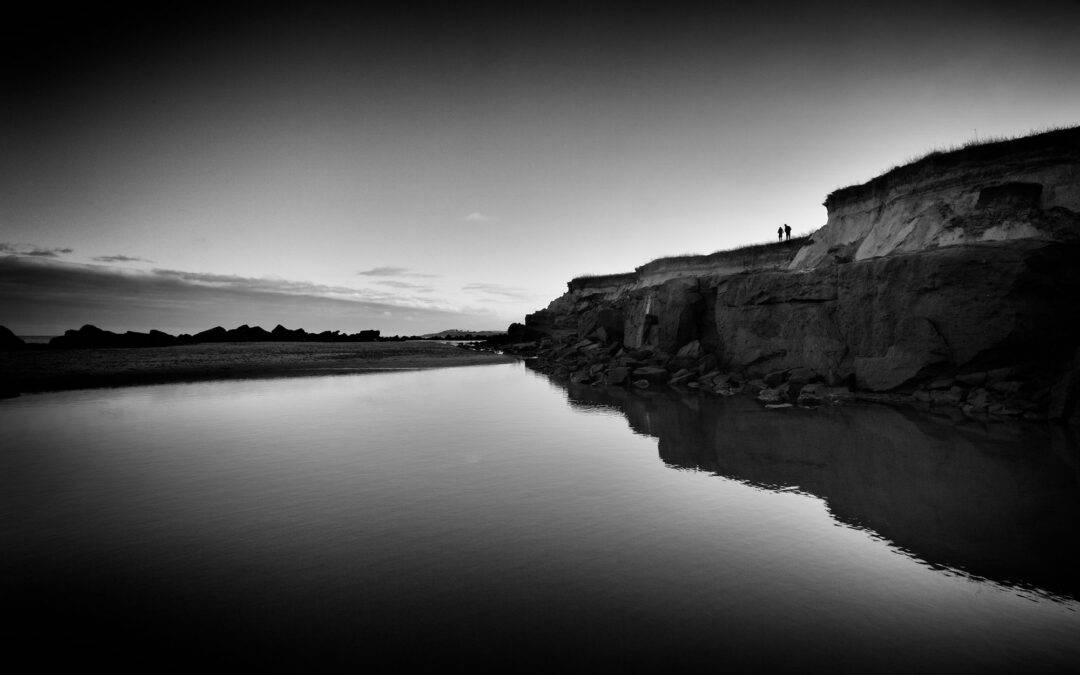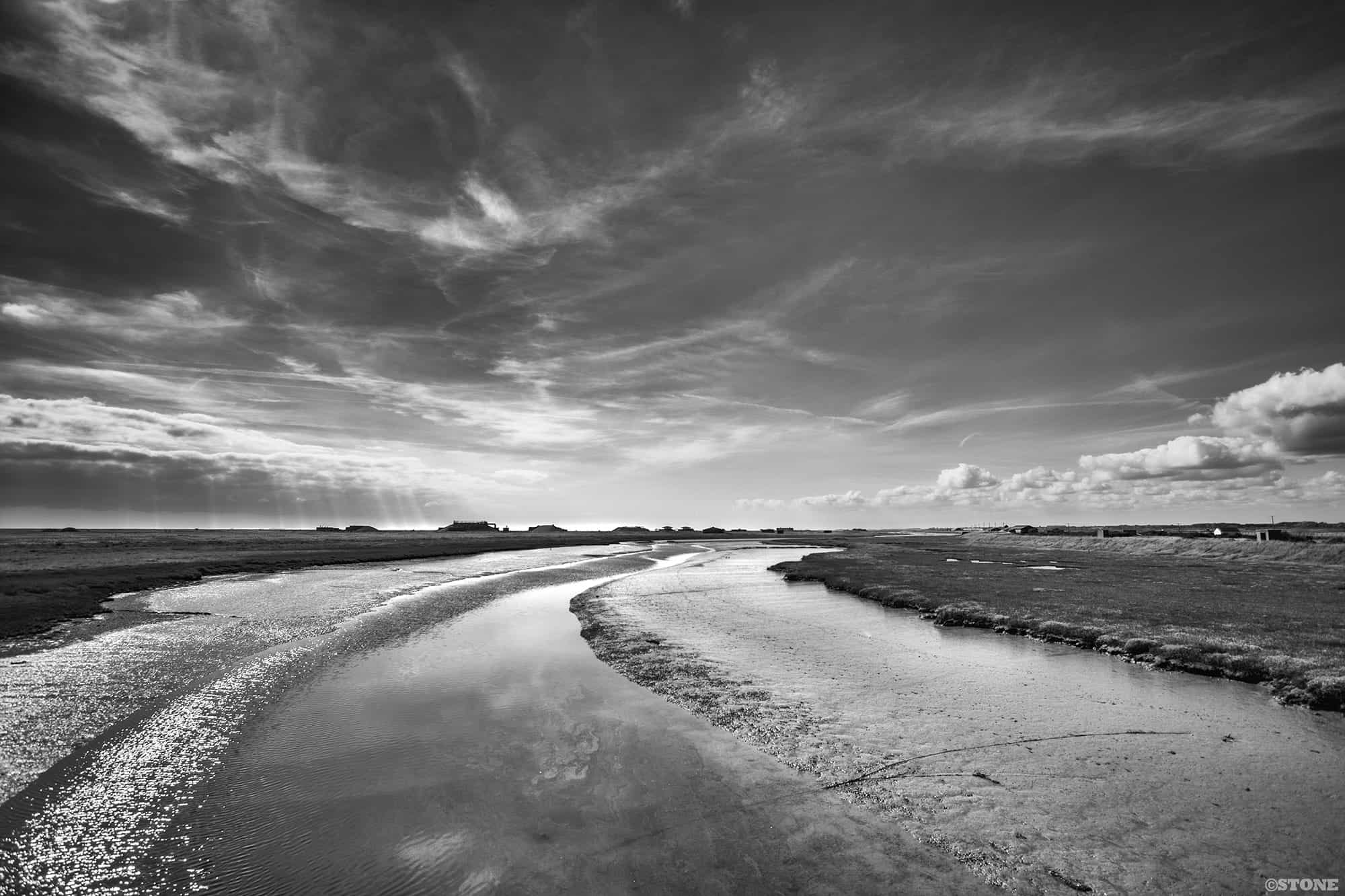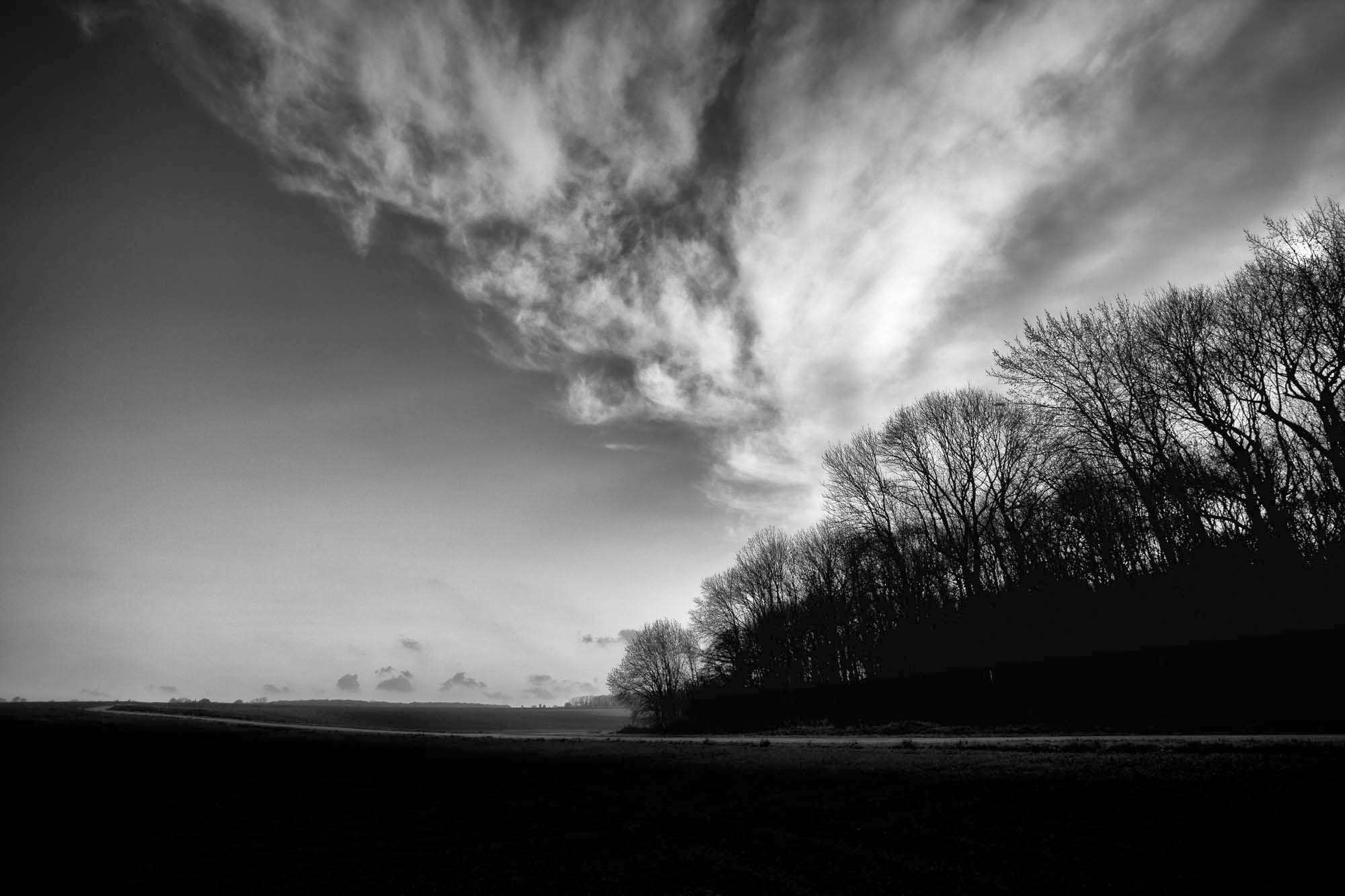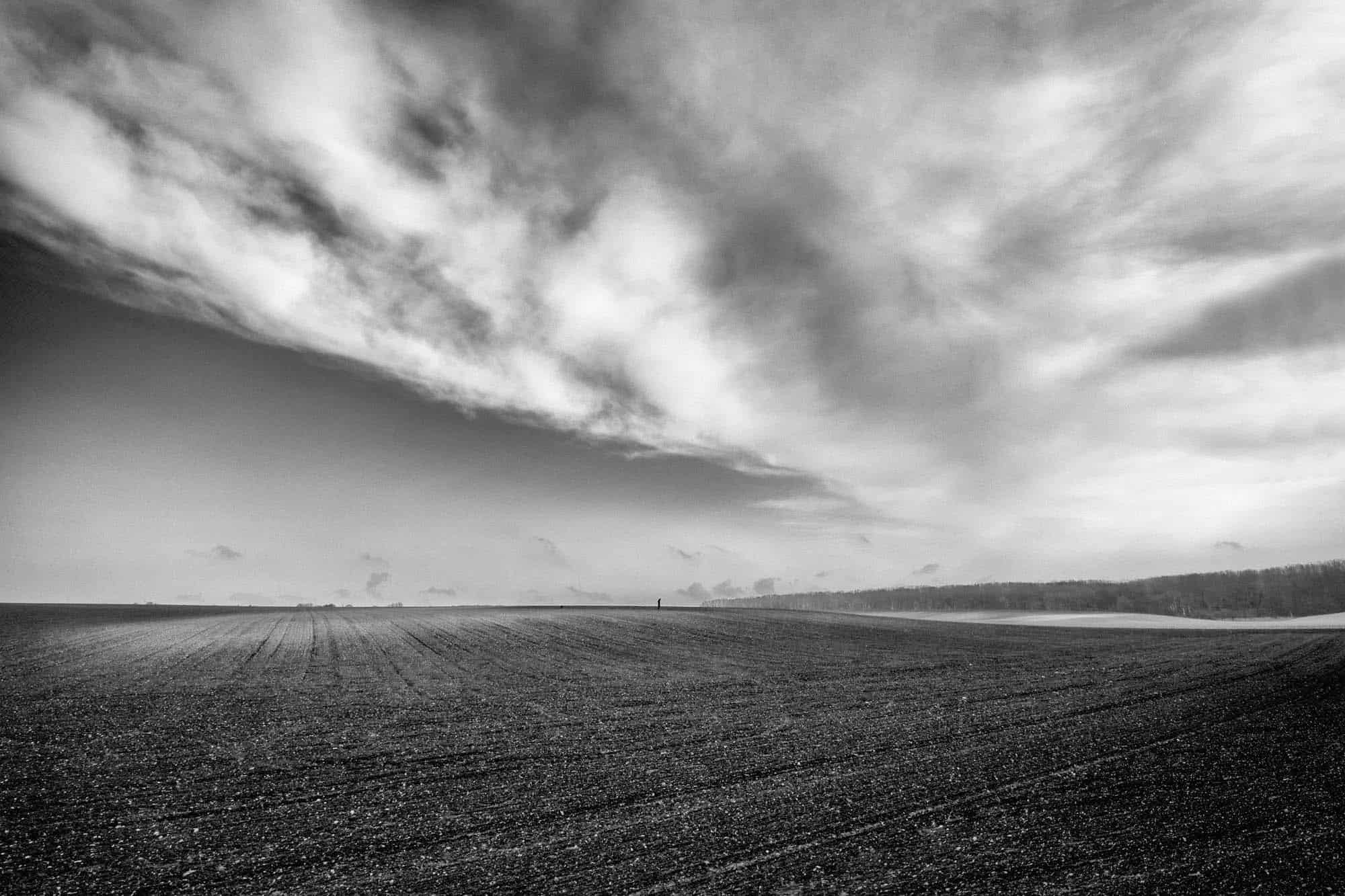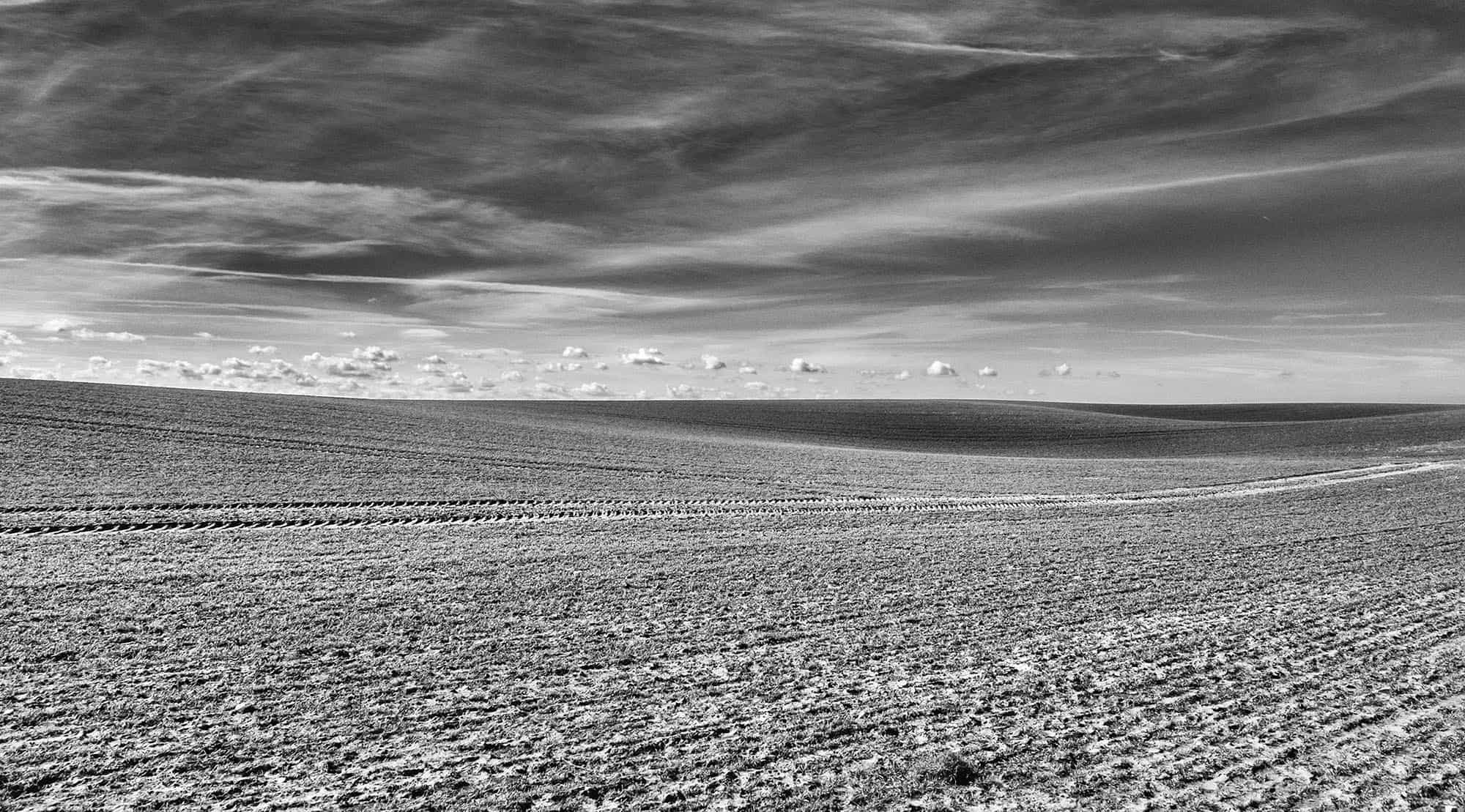An interview by Michéla Griffith, reproduced with kind permission of On Landscape magazine, April 2019.
For this issue, we have something a little different. Nick Stone describes his website, Invisible Works, as a series of fragmentary blogs and pieces about history, heritage and our place in the landscape. His photographs are supported by and integral with his writing about the traces that the landscape carries of our influence and interference – often things that we overlook, simply don’t see or choose to ignore. In some cases there is poignancy to these, to the events and places that we have forgotten, or to the lives lost:
Nick has spent the last six years investigating the scars and memories left by the Great War, culminating in the exhibition ‘Vanishing Points’. Wandering online, and off, is an important part of what Nick does, and what he finds.
Would you like to start by telling readers a little about yourself – where you grew up, your education and early interests, and what that led you to do as a career? I was born in London to elderly parents, both in their fifties. We moved to a council estate in Norwich when I was one. We lived there for a few years then moved to North Norfolk. I grew up in a typical country market town; they are by turns both intriguing places and pressure cookers with little to do when you’re young. But the countryside is on your doorstep. As you grow up you become aware of not just the nature, but the underlying history and the folktales that inhabit it, both the light and the dark. I left and moved back to Norwich in my teens and briefly went to art college, the focus of which was either painting or photography. Naturally enough I ended up doing neither and eventually became a designer, but composition and an aesthete is in your head, it’s part and parcel of most of the things I do.
How did you first become interested in photography and what kind of images did you initially set out to make?
I think I’ve always been interested in images; I painted, cartooned and drew a lot as a child. I became obsessed with cameras when my mum bought a box of junk at an auction and gave me a broken folding Brownie which was in there. I loved them as physical objects, took it to bits, tried to fix it, acquired a few others over time. In my mid-teens, I saved up money from a weekend job and bought a cheap Japanese Nikon-a-like which sufficed as an introduction to using SLRs. A friend’s dad had a darkroom in his shed, we messed about in there, discovering how to dodge and burn, how different materials behaved, different films, solarisation, a bit of push-processing, all those formative things. I can pinpoint where I realised I loved landscapes, a school trip to Yorkshire. I’d bought cheap red, orange and yellow filters so I experimented with shooting using those into a sea storm across the rock shelf in Robin Hood’s Bay, then the Abbey at Whitby and across the cup of the Vale of Pickering. I suddenly realised what you could make a sky do using them. Norfolk isn’t as flat as people think, but when you’re confronted with the edge of a huge low blowing in and the low organic curves and flat lines of what we are surrounded by here, it does make for some patterns and drama.
Who (photographers, artists or individuals) or what has most inspired you, or driven you forward in your own development as a photographer?
It varies, I draw inspiration from all sorts of sources and it is just as likely to be a song or lyric I’ve heard, a story or a piece of writing as a photographer or artist because life is complex and different bits join things together and it does become part of the stew of inbound and outbound links in your mind. Don McCullin made a huge impression on me as a teenager where those things meet via the use of his images on Killing Joke record sleeves which made me go sideways down that path. Equally stuff by Max Ernst and John Heartfield and its link to the artwork of Gee Vaucher and Crass. It’s actually quite difficult to define. I mean I like the magnificence of Weston, Salgado or Adams or the regimen of Gursky, but then some days it can be Arbus, Man Ray, Lee Miller, Capa, Brooks or local hero Olive Edis. Other days I can stare at Martin Parr’s or Jim Mortram’s work. You can’t live on the same things all the time. I am a bit of a butterfly.
I suppose this is in a similar vein to the way I’ll listen to Gang of Four or My Bloody Valentine one day and A Winged Victory to the Sullen or Jon Hopkins the next. At times you can just listen to things or see things and be struck by a feeling about how something might work or just read something, a poem, an overheard aside, a phrase in a book or an online interaction can lead places. Twitter especially can spark off a train of thought, so someone who takes photos or writes or produces music may share something and that will make me wander off and find out about it. I’m quite idiosyncratic I guess, and a bit autodidactic and eclectic in the way I discover and collect influences.
As well as photographer, writer and visual artist, you refer to yourself as a collector. What things do you collect?
I collect all sorts of stuff; it’s just part of my nature. I’m a bit of a magpie, and love material like field finds from walking – worked flint, rocks and fossils; things which give you a connection to a much deeper past. My last exhibition, Vanishing Points, featured a cabinet full of field-walked material from France and Flanders on a bed of soil; it added a dimension to it that made these quite austere black and white landscapes seem more real. My main thing though is rescuing old photographs, albums, glass plates and slides, other people’s memories if you like. Often they’re orphaned from the owners by time and circumstance which adds a certain mystique and occasionally allows the development of research, ideas and stories around them. This has led to producing some installations and visual arts projects with museums and heritage organisations; rephotography, mosaics, murals and montages, things that involve communities in photography as part of exploring our collective history are a fabulous way of binding communities together and understanding the depth of our social history. We all collect. It’s not just the physical things, we all constantly placemark, date stamp and bookmark things now, the nature of the internet, a replacement memory, an augmentation of it.
We often talk to photographers for whom walking is an important part of their relationship with the land and their creative process, and when we talked to Rob Knight recently the merits of embracing and exploring the unknown came up – in a sense ‘getting lost’. You refer to things being triggered for you by wandering both online and off, and I’d like to ask you to expand on the online part of that. We all now have a remarkable resource at our fingertips, even if we don’t always make the most productive use of screen time. What does the web offer you, and where do you enjoy wandering?
Digitally, all over the place; the internet really is a playground, it has opened up a huge set of resources. For me it’s always going to be two things, firstly the access to mapping and how you can route find and pinpoint things, and then secondly how you can apply the variety of resources which explain an environment to those points, so say spotting what could be a burial mound or a ruined church and then confirming it is using heritage records, then exploring that. The value is also there in how once you process these bits of information you can then share that data and add layers of knowledge and interpretation to things. Landscapes are deep, horizons exist which we wear into and can sometimes see, but can easily remain hidden; the resources online give us an opportunity to explore that and reshape how we interpret what we’re physically looking at and what is hidden out there in the field.
Has the nature of the places that you are drawn to changed over time?
I suppose so, yes. 15 years ago I was shooting a lot of material to do with dilapidation and development, more urban landscapes. I’ve always lived near the sea so that’s been a constant, and Norfolk skies are always there. The main themes I think that have remained fairly constant are to do with conflict, destruction and renewal; this is true of the rephotography work I’ve undertaken both to satisfy my own curiosity and as commissions. Developing a personal series of images of the blitz was fascinating, but equally working on projects involving urban redevelopment in Coventry and looking at market towns all have facets that draw you in, and give you a much deeper and more involved understanding of how our human geography develops and shifts.
Do you think that romantic notions of landscape still hold too much sway – even where our land doesn’t bear direct marks of development or industry, it has been altered by being put to its service? For example, in a Waterlands post, you talk about The Broads being the legacy of peat cutting for fuel but with nature’s makeover, I doubt many realise this.
I’m not sure they hold too much sway, there is room for us all and how we interface with our environment. There’s a fashion at the moment for producing a series of quite minimal images of edgelands and the kinds of hinterlands where humans sometimes deliberately, occasionally inadvertently, make a mark with our Anthropocene residues. Personally, I’m equally at home taking photos of a carrier bag stuck in a tree near a gas terminal as I am trying to convey some of the magic we are in fact surrounded by, but often don’t really notice. In fact, there’s a relationship there between what we find of the past and what we, in fact, leave now in terms of the material archaeology of the future, and you can convey both. A friend I went walking and shooting with on Dartmoor last year lost his phone on the top of the moor. At some point in the future there’s a chance someone may find that, we couldn’t so I’m not sure how big that chance is, but we do all leave residual traces which are evident in everything from litter and rust to pieces of worked stone, holloways and old tracks, wall lines and pathways; the form and structure of even wild places are shaped by us. I think it’s entirely possible for both landscape photography to exist in its formal established slightly grandiose manner and still contain the ordinary, and for the ordinary to be beautiful, and the magnificent quite ugly.
Your writing makes me think that in many respects as a people we have retreated from the land and the connections that bound us have been lost or buried. It isn’t just that there is a physical divide, but a mental and emotional divergence too?
This follows on neatly from the previous question really. We have retreated from the land and some of the resonance is lost. This is especially true in East Anglia. Norfolk has hundreds of deserted villages. They range across thousands of years of human activity and settlement, from hill forts to military training areas. The obvious ones are generally medieval. The keys to these are generally changing economic circumstances and greed. Factors range from erosion of our soft coast to emparkment and enclosure, landowners and flock masters and the shift to wool as a commodity, poor soils facilitated this in places; occasionally it might be disease. The Black Death is cited too often for the wrong reasons, it certainly depleted the population but, in fact, it necessitated and facilitated shifts in power in a similar way that the end of the Great War and Second World War did, with the poor in lesser numbers gaining more power to control their wage and place in society. Most desertion resulted in growth of the larger centres. Norfolk was very wool rich, the industry huge; you can see this in some of our vast but isolated churches, built using wool money.
There are clues all around, in place names, roads, patterns of settlement, where the old stately homes and halls are positioned all give away information on our changing landscapes, how settlements were formed and when. You can see the various influxes of settlers or invaders in the words, as far back as the Brythonic word Ouse for the river which flows into the wash, through Roman with our Castors, Burghs and Strattons, to the Anglian, Saxon and Friesian -Leys, -Hams and -Tons, on to the Vikings with their -Thorpes and -Bys and -Hows and the Norman influence on the names as they shifted with the reintroduction of romance elements to the common lexicon. This continues now – street names we introduce often allude to the famous or infamous, or a functional attribute of that area even now. I find this a fascinating by-product of my interest in how our landscapes form, one that actually underpins a lot of the aspects of how we understand what we’re recording.
Stratton Strawless is a good example of a combination of influences in a fascinating piece of Norfolk that most people drive by without thinking about. There are burial mounds in the woods and heathland nearby, a Norman castle up the road, Roman tile and brick in the fabric of a medieval church which itself contains a remnant of the crusades. Tombs to the Marsham family, of which
Robert gave us phenology to track the seasons and time itself using nature. The hall was used by the RAF during the Second World War. And as a name, Stratton Strawless gives us clues to Roman, Anglian and early modern. And it’s beautiful and bewildering, and somehow slightly forgotten, sitting there not far from a busy road. This interplay between different time-frames and the different horizons resonates particularly strongly in the Norfolk landscape. The solitary church away from a settlement, field marks on aerial photographs, layers of coast eroding and stripping back revealing the past, each thing is a story worth exploring and interpreting. Often partially hidden, these are all about humans. People existing, loving, living and dying, it is part of our relationship with the land over millennia mapped out in front of all of us, and with a bit of intelligence, we all have tools to look at it and understand the context we inhabit now in terms of the past around us.
At the end of the day though, you don’t actually really have to understand a landscape so long as you have ‘felt’ it, it’s made a connection between you and your contextual view of it and the dynamic that then connects your interpretation, whether in words or pictures, or both, with a viewer or someone outside that.
How important are people, their memories and family mementoes, as a resource to you in finding out about hidden places?
They have been tremendously important and still are. It’s via stories, my parents, grandparents, even distant relations and friends, that I quite often build pictures of how I want to shoot things or write about what I’ve shot. It’s through this that we maintain a connection and a sense of our place. When I write about things I like to weave material together, be it personal history, family or historical contexts, it’s that which really that makes us who we are. Ignoring the occasional heroics, it’s actually the banality of life. I think we concentrate too hard on who won this and who did that amazing thing and forget that most people, get up, go to work, eat, sleep, repeat, but contained in that set of processes are all sorts of fascinating minutiae about how we function, how we live and love and indeed die. It’s that spread of dust and fragments, the silver coating on pictures and the words that get left behind that attract me and giving them a place sometimes.
You’ve written about Vanishing Points – your personal exploration of and response to the landscapes of the Western Front – and that you’ve realized you’re trying to finish the unfinishable. Do you plan to continue or have you accepted that the interlocking layers will always retain some secrets? Your personal connection and the extended period that you’ve spent researching makes me wonder whether you will be able to find an endpoint that you are happy with?
I suppose I’ve sort of capitulated really. I could keep doing it forever, but there are other projects that need expressing. The exhibition was as near to an endpoint as I think I can get with it, although I’m being encouraged from various angles to produce a monograph edition of the series, with more writing and an extended set of photographs beyond the ones featured in the exhibition. However, I’m not yet convinced the uptake would be great enough to warrant it. So, although it’s never really over because these things lock into each other, it is at least back in a box for a while until I doubtless stumble on some other way they fit into something else I’m doing. It’s very hard sometimes to find edges and distinctions between projects, or indeed work out if everything isn’t just one giant project. There will always be secrets. History isn’t at its centre made, it’s written, so much of what we base our judgements on is heresy, it’s conjectural, or supposed, or near fact, constructed of newspaper reports and documents which clearly weren’t the reality of everyday life for most people out there or at home, “interminable boredom punctuated by moments of terror,” is one of the famous but more or less unattributable quotes. I can only guess really at what it must have been like for my family or indeed anyone either out there or at home.
The one thing that is a constant in Vanishing Points was change, the landscape encroaching on its own past like an ouroboros, eating itself. The whole of the Western Front is full of restless ghosts, what remains isn’t static; the tourist industry encroaches on places I remember from 20 to 25 years ago as being quite wild, there are fences and walkways appearing to ‘protect’ sites, you end up losing touch with the ground, hovering above what’s important, ghostlike yourself.
What do you hope might be the legacy of your research and writing generally?
I don’t know really. I never really set out to achieve anything specific, there’s not an endpoint in my head. It’s always been more about the process of exploring and creation. Anything that comes after that is really a bonus. The legacy is already there digitally. Exhibiting has added a formalised physical element to it which has been curious to develop for me as I’m usually creating things for other people such as some of the installations and exhibitions I’ve made for museums and organisations.
If we turn to the images, how do you approach making them? Are you looking for an aesthetic, a satisfactory composition, or is a representation of the memory more important for you?
That’s a tough question. I suppose it’s a combination and it varies, or perhaps is dependent on what things I’m thematically working on, so memory can be uppermost in some contexts where I’m wrapped into something by personal experience. I think understanding composition is something you just have in you, I rarely think about it. I suppose I shoot using that plus all the different parameters I’ve picked up over the years and the variations thereof, plus I believe it pays to not always follow the obvious line. I was recently talking to a younger photographer who expressed an interest in how I decide what to shoot and the advice I ended up giving them was ‘look for the most obvious composition you can find, then don’t do that, do something else’.
That said I’m probably as guilty as everyone of just thinking ‘Oh that’s nice, I’ll have some’ both compositionally and regarding aesthetics, but quite often it is about seeing beyond the tree line or the cloud and seeing how it fits together as a whole. Looking for patterns at play which naturally occur, playing a vague waiting game with light or weather, or taking a chance and hoping it works. Ultimately whatever you do you are making a reality, altering what is real to fit an aesthetic.
I’ve worked as a creative for thirty years and I think you naturally look for patterns compositionally – angles, lines, curves, the way a frame breaks up into sections, or what the dynamic is within an image or in life around you. It’s just about understanding how things work together. And whether you end up a creative because you already do that, or you do that, and end up a creative because of it, I’ve never been certain.
Will you choose 2-3 of your photographs (‘favourite’ for want of a better word – resonant perhaps) and tell us a little about the stories they represent and why they are special to you?
Orford Ness
It’s just such an extraordinary place; aside from the natural habitat, the sheer depth of history on the site is remarkable. It’s good to go somewhere and properly scamper about like an excited kid. It was mercifully quiet and easy to escape people, so the whole place felt quite isolated. When you look at the context of it all, this nature reserve with its history of weapons testing, the shingle, the arc of the sea, the links to the cold war… I found it by turns fascinating, chilling and extraordinarily haunting.
Lost light and Solitary fieldwalker
I think this was my fourth or fifth trip to France and Flanders in pursuit of whatever it was I was pursuing. The morning opened up with an early mist which had turned into fog in places; it quite suddenly lifted. I’d driven in a huge arc through various locations including where the Norfolk Regiment jumped off at Carnoy and ended up near Trones and Bernafay Woods. These were both scenes of fierce fighting in the summer of 1916. It was here I parked up and started walking in a fairly big circuit, stopping at various points to take it in and grab some photos, bits where I understood what had happened.
Then quite suddenly the light started to fail. It was spectacularly uncanny, just as I got back to the cemetery it was starting to spit, the sky caught the mood of the place. And there, in the field, was this lad, a French boy, in his late teens I’d guess. He was field walking looking for scrap in the earth, buttons, shrapnel balls and fragments. He was just over the back of where Edgar Riches, one of the men I’d been researching, had originally been buried – we raised a hand to each other and there was this almost synaptic connection between everything for a second. It still makes the hairs on my arms stand up thinking about it. (You can read more in Nick’s blog post)
I drown in the drumming plough land
Happisburgh is one of those places which is almost too easy to photograph. The beach, cliffs, pillboxes and broken sea defences are terribly photogenic in their advancing dilapidation and in the right light it has this almost apocalyptic feel to it. It all marks the loss of a settlement to the sea and with the environmental damage we are doing this is accelerating. This photo, however, isn’t that, because this is what time and erosion are gradually stripping back. Below these curves lie footprints of our ancient cousins impressed into the mud of an estuary of a buried river on a much older lost horizon, from around a million years ago. The surface isn’t giving much up, but sometimes knowing is enough.
Can you give readers an insight into your workflow: the cameras and lenses that you like to use and the part that post-processing and editing plays in realising your vision? I know that the latter gives you great opportunity to prick memories and consciences through the use of a number of techniques (georeferencing,
rephotography and colourisation).
I use an ancient Canon 5D2 which shows much scarring and wear. It’s served me well for a long time and will continue to do so until it eventually fails. I am a Canon boy and have been nearly forever. I tend to shoot most landscapes with a 17-40L but have various other lenses for different things like occasional product shoots and a fair bit of portrait work. I also have a Fuji X100s and the wide converter for those walkabout things when I don’t want weight. I love them both, the Fuji is very convenient too.
Because by trade I started out as a designer, I by habit use Apple equipment and Adobe software, and have done since the mid-1990s. I can’t shake using Bridge and Photoshop, I don’t get on with Lightroom and reverted fairly quickly after test driving it. But what I do works for me so that’s it really. I tend to shoot as if I were still using film and process in a similar way, so I don’t tend to fill cards with thousands of images. I shoot RAW and convert. Old techniques like dodging and burning still get used a fair bit to pick out and lift, levels, curves balancing, sharpening and so on.
Rephotography is a different thing. You are shooting really at the whim of a previous generation of photographers, so you have to be driven by their positioning and composition and try and make what you can out of that, good or bad. In some instances, you actually do end up standing exactly where they stood. I process the same way for the base image, then use layers to build up the ghosted images, erasing what I don’t need to be seen to get the best effect.
How important a part of the process for you is printing an image and what, for you, makes a good print?
It’s very important, screens are great, but ultimately you need to be able to see an image on paper to make it real as far as I’m concerned. I used to use a print house, which meant you have to hand over control, mostly that worked but eventually I bought my own printer as I can see exactly what I’m getting. It’s certainly no cheaper, but if I don’t like something I can change it there and then and reprint until I’m happy. Testing was important, I’ve alighted on materials I like and processes I trust, and you can’t really want much more than that.
If you had to take a break from all things photographic for a week, what would you end up doing? What other hobbies or interests do you have?
Just the stuff I do anyway probably; music, wandering, writing bits and bobs, I like making things too as a therapeutic distraction. I don’t constantly shoot, luckily my work life is terrifically varied and a week away from a camera isn’t actually that unusual in reality.
Thanks, Nick – you’ve given us all plenty of food for thought.

